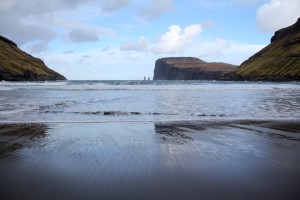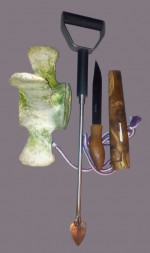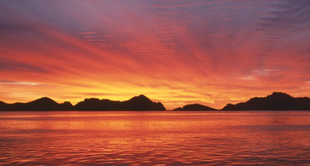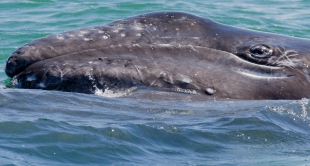Pilot whales (Globicephala macrorhynchus) are settled at the waters of the Canary Islands.
Regularly they are travelling between Tenerife and La Gomera back and forth.
Mostly they are staying in the waters with a depth around 1000 m, where they chase their favorite food – squids and cuttlefish. These very special and majestic sea mammals can be admired from whale watching boats. Due to the fact that they rest at the water surface during the day, they are easy to find. Being permanent residents in this area, they are well investigated and identified.
On few occasions we could observe a very special behavior: Something was carried in the mouth of the pilot whale while swimming. Only by coming closer to the whale we could identify what it was: A dead calf. The mother carried it in her mouth for days and kept on trying to bring it up to the surface so that it could breathe.
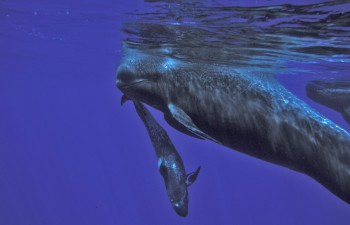
Probably she was lamenting the loss of her child. Not only has that fact allowed the conclusion, that the families of pilot whales are held together by a strong social net. Up to the age of three the calves stay close to their mothers. Pilot whales are also known for their distinctive assistance behavior. They have been found in other areas of the world stranded in big pods due to their strong social bonds.
Matriarchies
Matriarchies are part of the bond inside the clan, which lives on the Canary Island. One of their leaders is named “Isora” in the documentary of Aquawork productions. She is an elderly female and also the matriarch as well as the head of a big school. She is leading the group. Just like Orcas do and sperm whales the elder females set from the front. At the age of approximately 40 years they stop giving birth. But under good circumstances they keep on living up to 30 years more. Then they are supporting younger mothers and pass on their experiences and secrets to following generations.
Cheetah of the depth
The marine biologist Volker Boehlke explains during the “Oceanic week intensive” on La Gomera (www.oceano-whalewatching.com) that the pilot whale is also called “cheetah” of the depth. By now it is known what the animals do during the night: The top athletes go hunting squids, which are coming up to around 1000m to feed themselves.
Pilot whales dive up to 700 m deep and are faster than any other whale. Diving profiles show that the starting speed of a dive can be 2 m per second. In case a pilot whale has located its prey it can speed up to 7 m per second.
During day time they take a rest from their nightly extreme sports. This are the moments we come across them and enjoy the beautiful encounters.
It is also possible to meet the sea mammals in other parts of Europe, e.g. in the Straits of Gibraltar. These waters are full of shipping traffic, which is a real hazard for the animals. The noise increases, also the risk of collisions.
More sheep rather than humans
On the Faroe Islands, which belong to Denmark and isn’t part of the EU, are living more sheep than humans. Pilot whales are known here for a sad reason.
On the remote 18 Islands, on which you will never be farer away from the ocean than 5 km, whole groups of whales are slaughtered (approx. 800 animals per year). In former times the inhabitants were dependant on the meat as a source of nourishment. Nowadays the haunting is still pursued due to commercial reasons, although the recommendations concerning health are not to eat more than 250 g whale meat per month (max. 50g of the fat/bubber). Especially mothers shouldn’t eat the meat at all because it is full of heavy metal (as well as PCB).
Of course the difference of eating a piece of beef and a piece of whale meat might be discussed, in case one is still eating meat. Fact is that the meat of a whale, which stands at the end of the food chain, is clearly more poisoned with harmful substances.
Marna Olsen, who came to La Gomera to take part on a behavioral biology course of M.E.E.R.e.V. (www.m-e-e-r.org), is pointing out to these circumstances. She cleans up with some misunderstandings: The haunting of the sea mammals is neither a festival/ ritual for juveniles becoming a man nor a commercial business. The animals are haunted the whole year long, whenever they are around. As soon as they are sighted the message goes around the islands and fishermen coming together to start the slaughter. It’s nothing for the faint hearted.
Once driven in the bay (there are 23 bays which do have the permission by authorities) the whales strand. A hook is fastened at the blowhole so the animal can be pulled to beach. With the help of a “spinal lance” the animals are killed in a couple of seconds. A fisherman needs 10 minutes to kill a whole group.
But the haunting is still quite cruel: The pilot whales become fearful and terrified at that moment, the “drive” starts. Calves, young animals and pregnant females are slaughtered: the whole group. It can’t be avoided, that the calves witnessing the death of their mothers and the other way around. Also it might be assumed that the death does not come as fast as desired, so the animals are suffering a lot.
For Marna Olsen it is not easy to raise her voice in an environment where “pro-whaling” is still the norm (www.whaling.fo) and where it is extolled as a modern, retro romantic lifestyle.
A voice for pilot whales
She wants to create an opposite point of view to the haunting of these social and intelligent animals, which is still taken for granted. The very fact that the pictures of the pilot whales turn out so beautiful and special makes it worth having a look on the English speaking website.
You have to build your own opinion: At which point starts human acting in the area of protection of animals and where does it end?
I am glad having received information directly from Marna and I understand the behavior of the proud people living on the Faroe Islands (although I don´t share their opinion). Furthermore I really respect the courage of this gentle woman, to draw the attention to this unpleasant topic.
Protection of the ecosystem sea
Whales are an important part of the complex ecosystem (e.g. due to their ferruginous excrements), even beyond their death. The carcass sinks to the ground, where innumerable little animals wait for the remains of dead animal bodies, on which their survival is depending on. In some parts of the world, e.g . in the Antarctic, there is not much sinking down any more. The whales are haunted and pulled out of the water, before they die a natural death. Furthermore the haunting has almost extinct the whales in the Antarctic waters.
At the following day I could enthusiastically observe a pilot whale in front of the coast of La Gomera. A calf was inspecting our boat until her mother called it off. I am glad that at least these animals remain untouched by the whaling.
More and more I realize the importance of the sea mammals. The more they tantalize the humans, the more people are paying attention to the ecosystem, which needs our care and protection in most respect. On account of the sea mammals! On account of us! And on account of the climate! This is essential to life and not optional anymore.
Susanne Braack
www.oceano-whalewatching.com



